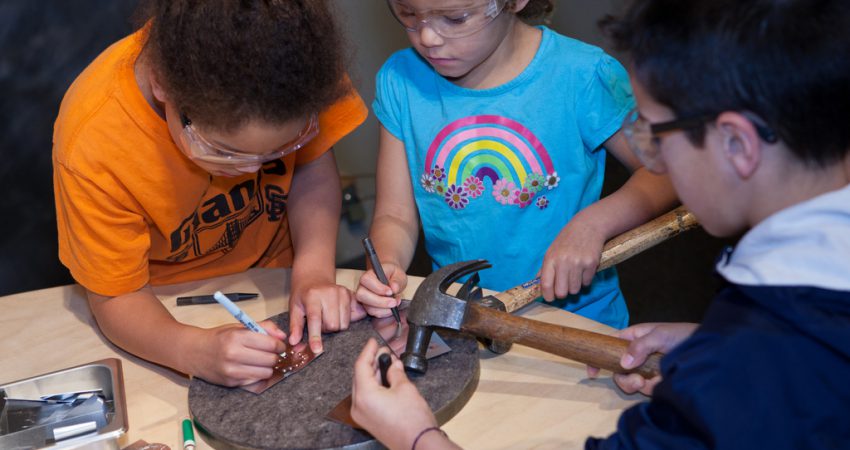
By Melissa Ballard - 2015 - November 2015
PAPER CITATION
Evans, M. A., Lopez, M., Maddox, D., Drape, T., & Duke, R. (2014). Interest-driven learning among middle school youth in an out-of-school STEM studio. Journal of Science Education Technology, 23(5), 624–640.
In this paper, Evans, Lopez, Maddox, Drape, and Duke investigate how intentionally designed features of an out-of-school time program, Studio STEM , influenced middle school youths’ engagement in their learning. The researchers attended to the following key aspects of the program design:
- Engineering design and problem-based learning. Participants worked on an engineering design challenge framed by an environmental issue. Students designed and built a solar-powered vehicle to transport seagull eggs out of danger from rising sea levels.
- Integration of new media. The new media used included social networking forums, interactive media and productivity tools, and mobile computing. Participants used iPads and Notebook+, a multimedia journaling app, to conduct research and record iterations on their designs. They also used Edmodo, an online social network, to share knowledge, ideas, and results with other groups.
- Peer interactions. Students collaborated in small groups to design their solar cars, modify their designs, and prepare for the culminating presentation. Intergroup interaction was encouraged and supported through Edmodo.
- “Studio” environment. The classroom was set up in several workstations, each addressing a key curriculum concept. Students were free to rotate among stations throughout the one-week project to gather information that would inform their designs and iterations on prototypes. The studio environment supported the three program design elements listed above.
- Alternative assessment and student motivation. Students were encouraged to complete badges as they mastered the scientific content featured at each workstation. Badge completion and small-group presentations at the concluding symposium were alternative forms of assessment intended to foster student motivation.
Research Design
The study addressed the following questions:
- What role does the engineering design process play in motivating youth toward deeper learning—that is, learning that can transfer across disciplines and contexts?
- What role do technology and social networking forums play in motivating youth toward deeper learning?
Researchers studied a one-week summer session of Studio STEM in which 15 middle school students from rural Virginia participated. Two students were chosen for in-depth case studies: Ryan, an 11-year-old female student attending a public middle school, and Sam, a 13-year-old male student attending a private school.
For each case study, researchers analyzed video interviews, field notes, Edmodo chat logs, and Notebook+ artifacts. Pre- and post-participation assessments, delivered through Edmodo, attempted to assess deeper learning.
Research Findings
Both Ryan and Sam were motivated to complete their vehicle designs with their group and persisted through multiple iterations. However, they related to different aspects of the design process.
Ryan took on a leadership role and encouraged her group to stay on task. Her group revisited the workstations as they followed the design process, using the workstations’ content to help them figure out why their designs failed. Ryan consistently used Notebook+ and Edmodo.
Sam and his group were highly motivated by the prospect of designing the winning car. They often sought facilitator knowledge on science concepts that could inform an improved design. Sam also extensively used new media both to support the design process and to interact with peers.
Neither Sam nor Ryan was particularly motivated to complete the badges associated with stations or to get the most badges. Sam and his group explicitly stated that earning badges was unnecessary. Ryan’s group spent the first day completing badges but then concluded that the badges were not the main focus—they just needed to obtain the information necessary to build the best solar vehicle.
The symposium presentation proved to be highly motivating for most students. Ryan wasn’t personally interested in the symposium, although her team members were. Sam spent most of the final day creating and editing a video for his team’s presentation.
Theoretical Basis
Connected learning principles (Ito et al., 2013), which intentionally leverage students’ interest in digital media and communications to drive learning, strongly informed the design of Studio STEM and the research questions in this paper. Connected learning approaches have the potential to engage youth in self-expression and social interaction, lower barriers to accessing information and knowledge, provide social supports for learning, and make space for diverse expertise and cultures.
Implications for Practice
Studio STEM can provide a model for informal science program designers who are considering integrating new media into curriculum or are interested in motivating students in STEM learning. The case studies illustrate high levels of collaboration among peers, persistence through design iterations, and consistent and meaningful use of new media. The model provides multiple points of entry into STEM learning and recognizes the variety of ways students are motivated to engage with STEM.
Both Ryan and Sam had previous experience using productivity tools on computers. Further research would need to tease out what instructional strategies to use with students who are not experienced with academic use of new media or technology. Another study from the lead author (Evans, Won, & Drape, 2014) may be useful in probing the specific ways in which new media fosters engagement to boost interest-based STEM learning.
References
Evans, M., Won, S., Drape, T. (2014). Interest-driven learning of STEM concepts among youth interaction through social media. International Journal of Social Media, Interaction, and Learning Environments, 2(10), 3–20.
Ito, M., Gutierrez, K., Livingstone, S., Penuel, B., Rhodes, J., Salen, K., Schor, J., Sefton-Green, J., & Watkins, S. (2013). Connected learning: An agenda for research and design. Irvine, CA: Digital Media and Learning Research Hub.




